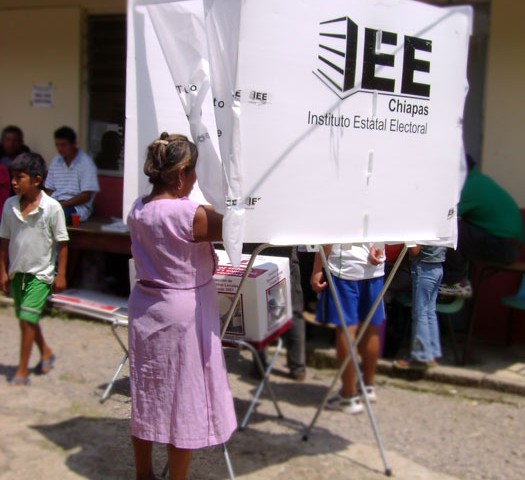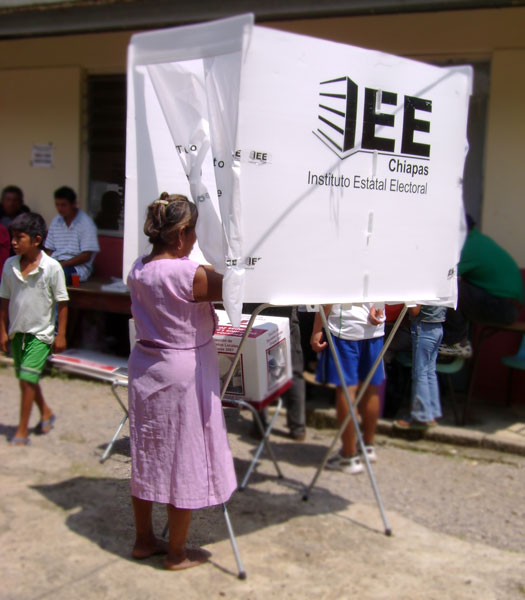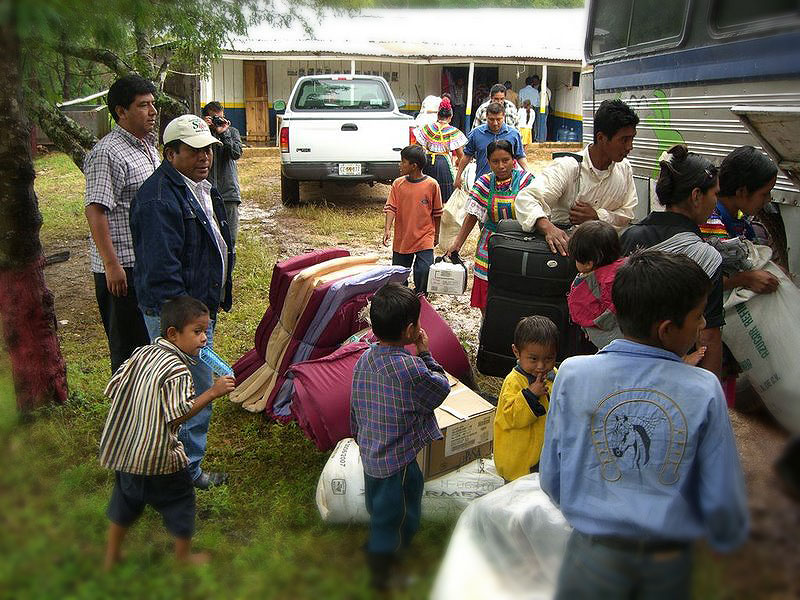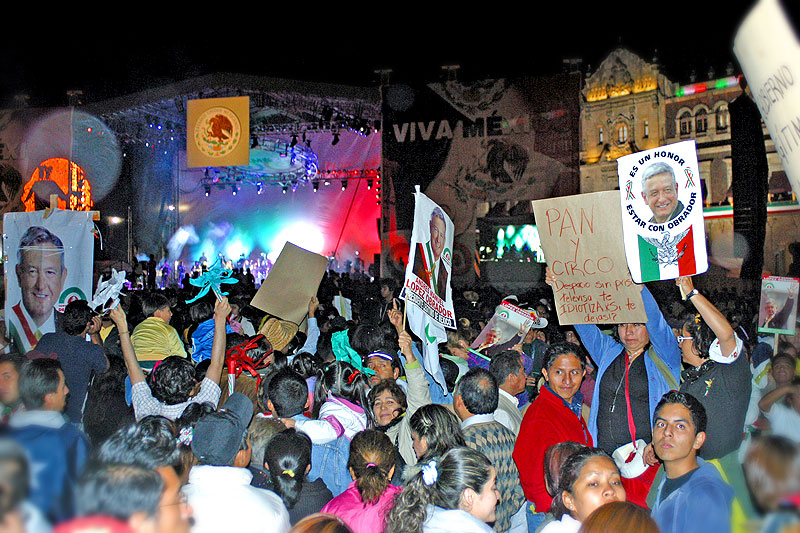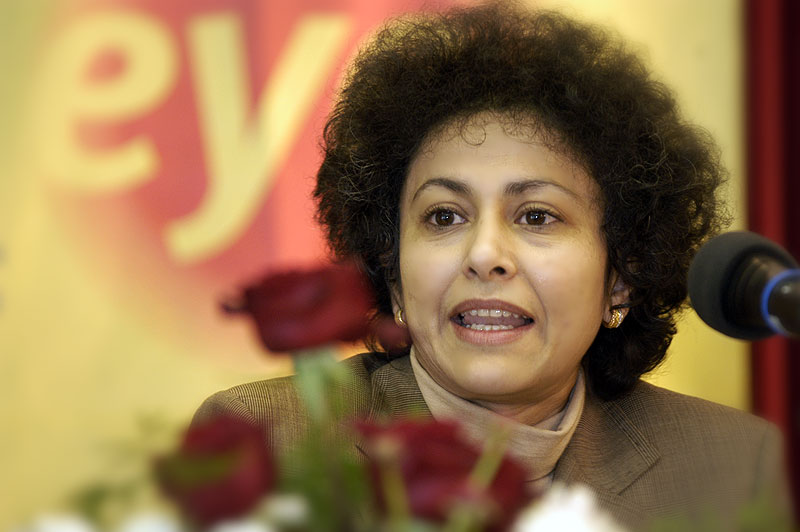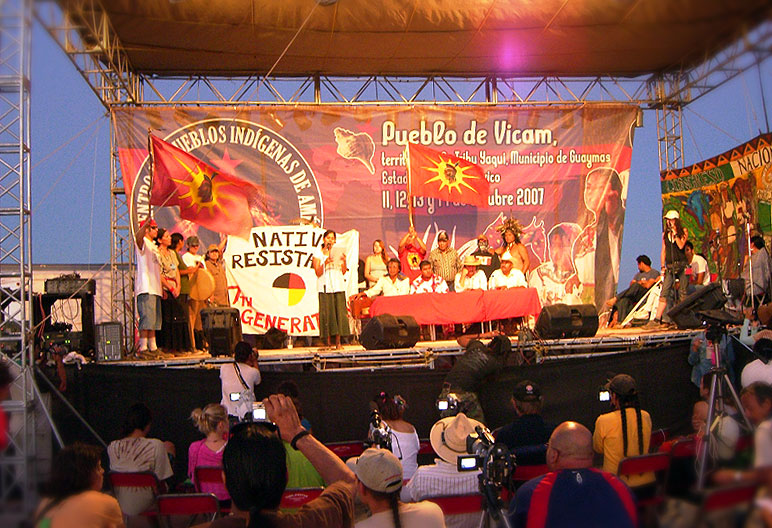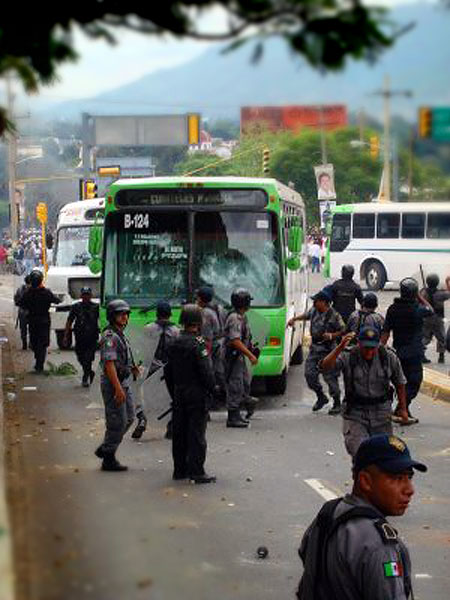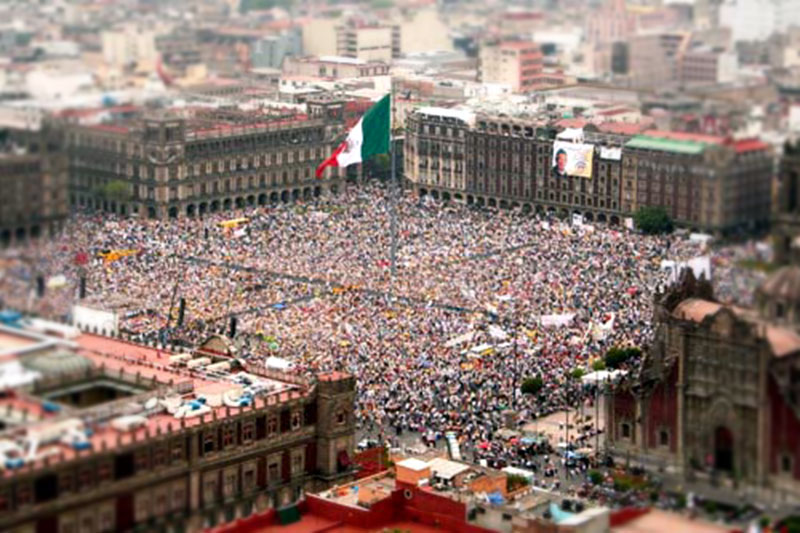
ANALYSIS: Mexico – A year after the 2006 elections
31/08/20072007
01/01/2008At the beginning of October, the Network for Peace (conformed by 17 Chiapas-based organizations) denounced the violent atmosphere, which has characterized the situation in Chiapas over recent months. While several political actors and the local papers focused on the elections, an increasing number of situations involving harassment, violence and evictions passed almost unnoticed, apparently considered to be isolated incidents.
Elections: The tip of the iceberg
On 7 October, elections were held in Chiapas. In dispute were 118 municipal presidencies (mayoralties) and 40 local deputies. Before the elections, the Chiapas Electoral Commission had received 43 complaints of presumed electoral crimes, the majority being premature political campaigning, destruction of advertising material, buying and forcing voting, diversion of public funds to campaigns and the participation of civil servants in support of certain candidates.
The day of the elections were marred by a series of violent incidents in Pueblo Solistahuacán, Venustiano Carranza, Simojovel and Comitán, among other locations. The bulk of the media, electoral authorities and the Government itself opted to minimize these incidents. Once the results were released, protests were announced in a dozen municipalities.
According to official figures, the highest voter participation in the history of the State’s elections was registered at the ballot-boxes, with 57.17% of voters participating. The Institutional Revolution Party (Partido Revolucionario Institucional, PRI) won 52 of the 118 councils in Chiapas, the Democratic Revolution Party (Partido de la Revolución Democrática, PRD) was left with 31, while the National Action Party (Partido Acción Nacional, PAN) will administer 23 councils, according to statistics provided by the State Electoral Institute (Instituto Estatal Electoral, IEE). In addition, of the 40 deputy positions contested, the PRI won 14, the PRD 10, the PAN 7, the Mexican Greens (Partido Verde Ecologista de México, PVEM) 3, the New Alliance Party (Partido Nueva Alianza) 2, the Workers’ Party (Partido del Trabajo, PT) 2 and Convergence (Convergencia) 2.
Given the imposition, decomposition and recomposition of the political parties and grassroots organizations which participated in the electoral process, it may be difficult to interpret these results. One of the worrying factors is related to the political timeline of certain winning candidates, independent of which parties they currently represent. Paradoxically, the gains of the PRD are considered by some analysts to represent a return of the old PRI. The Zapatista National Liberation Army Ejército Zapatista de Liberación Nacional, EZLN), speaking through Subcomandante Marcos, denounced: “With Sabines and the PRD, the landholders have returned […] The same ones who said that the life of an Indian was worth the same as a chicken’s.”
Increase in conflicts, particularly agrarian ones
Before listing a series of aggressions and intimidations, the previously cited communiqué of the Network for Peace alerted: “Beyond the electoral context, during the first nine months of the Federal Government of Felipe Calderón and the State Government of Juan Sabines Guerrero, indigenous territories in Chiapas, particularly areas of Zapatista influence, have suffered a new offensive. This repressive strategy has included actions organized jointly between the approximately 80 permanent military encampments, local authorities, agrarian institutions and groups identified as paramilitaries who hide behind the acronyms of peasant farmer (campesino) organizations.”
According to the Center for Political Analysis and Social and Economic Research (Centro de Análisis Político e Investigaciones Sociales y Económicas, CAPISE), thousands of families are at risk of being evacuated from their lands, which would be “the most brutal attack to be seen in the last nine years”, and result in a “mass, systematic and a priori legal” land plundering. According to their analysis, the main objective is to remove all of the land “recovered” by the Zapatistas after the armed uprising of 1994.
In October, the EZLN denounced that there has been an increase in military and paramilitary harassment since the government of Juan Sabines came to power. In September, the group Las Abejas in the municipality of Chenalhó (location of the 1997 Massacre of Acteal) became another group to denounce the increasing paramilitary and governmental offensive: “The well-known low-intensity war against the communities who fight against the neoliberal system doesn’t seem to have ended with the departure of the PRI governments.”
Additionally, since the beginning of the year, the Federal Electricity Commission (Comisión Federal de Electricidad, CFE), accompanied by the State’s Sectorial Police, has been conducting major electricity cuts, which have provoked confrontations in various communities. It is worthy of note that more than 350,000 residents in Chiapas refuse to pay their electricity bills as they consider them too high.
Another conflict highlighted concerns that have been developing over several years about the Biosphere Reserve in Montes Azules. On Saturday August 18, a simultaneous police and military operative moved to evict the communities of Buen Samaritano and San Manuel in the municipality of Ocosingo. A total of 6 families (39 people) were evicted. Six men were detained for the crimes of plunder and ecocide before being freed some five weeks after legal proceedings were halted. Five other unofficial settlements are at risk of eviction. The environmental organization Woods of the People of the Southeast (Maderas del Pueblo del Sureste) informed that the violent eviction operations in the communities of Montes Azules had yet to end and that “they form part of a global strategy of clearing territories rich in biodiversity, forest cover and sources of unpolluted water, both in Mexico and Mesoamerica.”
… … … … … …
National Situation
The Network for Peace, in their October communiqué, also emphasized: “Nor are we able to understand these facts without taking into account what is happening in the national context, where we see widespread military deployment, and a tendency to repress grassroots organizational processes.”
A division which remains unhealed
On September 1, President Felipe Calderón delivered his first governmental report while surrounded by a strong police presence. In a ceremony which lasted less than five minutes, Calderón delivered his report to more than 100 empty seats, as the legislators from the left chose to leave Congress to highlight the fact that they don’t recognize Calderón as president as he achieved his position through electoral fraud. In large measure, Mexico remains divided by the close victory which the Electoral Tribunal of the Judicial Power of Federation (Tribunal Electoral del Poder Judicial de la Federación, TEPJF) granted Calderón, whose government faces a national resistance movement led by the former left-wing presidential candidate, Andrés Manuel López Obrador.
In terms of the report itself, the President promised to continue to fight poverty and create employment, as well as fighting drug-trafficking and organized crime. In response to the questions which have been raised, Calderón highlighted the serious repercussions of the economic slowdown for Mexicans. Examples are the increase in the price of tortillas and other basic food products, as well as the increase in the cost of petrol. Nor has there been a significant increase in the level of employment, which has resulted in increased migration to the United States, despite the construction of the US-Mexico Border Fence and the deaths of hundreds of Mexicans trying to cross it. It is worth noting that, according to data from the World Bank, just over half of the 104 million Mexican citizens are considered to be living in poverty (with 24% living in extreme poverty).
Additionally, the fact that Felipe Calderón has placed the institutional stability of the government in the hands of the Army has been strongly questioned. Despite his report’s emphasizing that “this Government, as never before, has used all the strength of the Army to recover the spaces co-opted by drug-trafficking groups and other criminal organizations”, the major “antinarco” operatives have not yet had the desired results. Finally, selective repression of grassroots movements has also been denounced.
Another incident occurred in September, during the commemoration of the Independence of Mexico, which bears witness to the continuing political and social rift resulting from the 2006 presidential elections. On the eve of the celebration, the Main Square of Mexico City, protected by members of the Federal Preventative Police (Policía Federal Preventiva, PFP), was disputed by supporters of former presidential candidate Andrés Manuel López Obrador, to the motto “The cry of the free”, and the organizers of the official ceremony. López Obrador himself led the ceremony of the Cry of Independence in San José Tenango, in the municipality of Oaxaca.
Electoral reform: An opportunity to overcome polarization?
In September the Senate approved an electoral reform which reduces the costs of campaigns and elections, bans political parties and third parties from buying advertising time in the electronic media, limits the “dirty war” during the campaign period and the promotions of civil servants, while giving greater sanctioning powers to electoral officials. Many aspects of this reform are directly linked to the denunciations, which were made in the aftermath of the 2006 presidential elections.
In another positive move, the electoral reforms delimit the growing political power of the television consortiums; in addition to the money, which they will no longer receive from these advertising campaigns, their capacity to “influence” will be greatly reduced in the electoral process. A point to bear in mind is that in the last elections, political parties spent nearly 70% of their State-allocated campaign funds on buying radio and television time.
On September 11, in an unprecedented meeting between politicians and media representatives, a television announcer stated to television cameras and microphones that professional politicians were seen as having a lower level of credibility than the television companies. The National Chamber of the Radio and Television Industry rejected the reform, arguing that some of its clauses limited freedom of expression.
In any case, the removal of the President of the Federal Electoral Institute and the electoral reform could contribute to overcoming or reducing the polarization, which remains from the last presidential elections. On the other hand, in the discussion of this reform and in other aspects of political life (including internal elections in the PRD), it would seem to strengthen the moderate and institutional wing of the PRD itself, to the detriment of its so-called “confrontational” side centered around the figure of López Obrador.
During the period covered by this report, a fiscal reform was also approved. Despite being much weaker than the bill drafted by the Executive, this reform improved the image of Felipe Calderón as he can now, compared to former President Vicente Fox, achieve reforms with the approval of Congress. However, in September, the Chamber of Senators rejected the legal reform suggested by the Executive, which granted powers to the police to intercept telephone lines, carry out searches or detain alleged criminals without a warrant. The legislators argued that Mexico lacked sufficiently trained and trustworthy personnel within the public forces to guarantee the maintenance of human rights norms during the application of these laws.
… … … … … …
Mexico: “Schizophrenic” human rights policy
During her visit to Mexico in March, Irene Khan, Secretary General of Amnesty International (AI), stated that the Mexican Government had a “schizophrenic policy” with regards to the defense and promotion of human rights. “Mexico is one of the strongest promoters of fundamental rights abroad, but here at home we find serious violations of these guarantees,” Khan said. She affirmed the existence of systemic failures of the Mexican justice system, perpetuating impunity, a “cancer with long roots”. She continued, “The President recognizes that the system has problems, but he recognizes it from the perspective of crime and not from the failures in human rights.” She finally warned, “This administration is interested in promoting reform, but it hasn’t been clear about the position that it will take with regards to human rights.” Both, Ulises Ruiz, Governor of Oaxaca, and Francisco Ramírez Acuña, Government Secretary, questioned AI about the sources they used to reach the conclusions in the Mexico report.
The National Human Rights Commission (Comisión Nacional de Derechos Humanos, CNDH) continues to demand that the Army be removed from the fight against drug trafficking because of the potential risk of human rights violations. In August, the newspaper The Washington Post confirmed that the Governments of Mexico and the United States were close to sealing a broad agreement in anti-drug cooperation, which would represent “the most important alliance of its kind since the inception of Plan Colombia”. It would include telephone interception equipment, radars to trace drug shipments, planes to transport Mexican agents, as well as several training programs. Although the details of a bilateral agreement of this kind have yet to be revealed, as a result of doubts raised with regard to Plan Colombia it is feared that this option could imply restrictions of basic human rights.
… … … … … …
The Other Campaign And Other Social Movements
The Other Campaign
On September 24, the EZLN decided to suspend the tour of Zapatista commanders, originally planning to travel to the southern and central areas of Mexico between September and December. The decision was made as a result of what has been considered an offensive against Zapatista communities, undertaken by the Government via military, paramilitary, legal, agrarian and environmental channels. Another factor was related to the multifaceted campaign of the Popular Revolutionary Army (Ejército Popular Revolucionario, EPR) “with the just and legitimate demand to recover their disappeared colleagues”. According to the EZLN, “we can’t ask the EPR to declare a truce merely to allow our delegation to pass through territory where they are present or have influence.”
Following this, the EPR absolved the EZLN of responsibility in any actions which may occur in coming days as part of their campaign to demand the handover of two of their militants, disappeared in Oaxaca since May 2007. PEMEX (Mexican Petroleum) has given a tally of more than 3,000 million pesos of damage caused by the September attacks on the gas pipelines in Veracruz and Tlaxcala, for which the EPR has claimed responsibility. The Attorney General of Mexico, Eduardo Medina Mora, assured the public that the EPR is a weakened organization and classed their actions as terrorism and sabotage, rather than social struggle. The EPR responded by affirming that the true “terrorists” are in the Government, the police and the oligarchy which rules Mexico. “There are those who condemn and disqualify our actions in self-defense by labeling us as delinquents and terrorists, but they remain silent before State terrorism and the acts of the far right.”
Between October 11 and 14, in the Yaqui community of Vícam (Sonora), the Meeting of the Indigenous Peoples of America was held, called by the traditional Yaqui authorities, the National Indigenous Congress (Congreso Nacional Indígena, CNI) and the Sixth Commission of the EZLN. Initially it was uncertain whether the Meeting could be held, as the organizing committee denounced the fact that there had been both an attempted boycott by Yaqui authorities aligned with the Government, and police and military harassment. A week before the event, the Zapatista delegation was detained at a Mazatlán, Sinaloa, checkpoint by military and legal agents. Subsequently, the Zapatista commanders returned to Chiapas, leaving Subcomandante Marcos as the Meeting’s only EZLN representative. Some delegations participating in the event also denounced that police and/or soldiers who intercepted them on their way to Sonora confiscated their food supplies and treated them with overt hostility. On the outskirts of Vícam, surveillance by the Federal Preventative Police and the Sonora State Police was maintained throughout the event.
Some 570 indigenous delegates from 12 American nations attended the Meeting, representing 66 indigenous peoples. Juan Chávez, Purepecha representative and member of the CNI, said at the beginning of the event: “Holding this event, on these lands, is in itself a message of rebellion from our peoples, in defense of Mother Earth and against ecocidal, ethnocidal and genocidal capitalism. This capitalism tries to evict us from our lands, inhabited by the first representatives of the nations, peoples and tribes of America and the world.”
In October, more than 100 groups which form the National Front Against Repression (Frente Nacional Contra la Represión), highlighted what they term as a new stage of a dirty war against social justice activists in the hope of avoiding “another bloodbath caused by the State’s repressive apparatus”. The participants considered this a repetition of a 70s’-style pattern of clandestine torture, persecution and disappearances conducted against those who demanded political and economic change.

